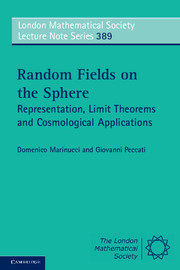Refine search
Actions for selected content:
3023 results in Probability theory and stochastic processes

Martingales and Stochastic Integrals
-
- Published online:
- 07 October 2011
- Print publication:
- 13 September 1984

Random Fields on the Sphere
- Representation, Limit Theorems and Cosmological Applications
-
- Published online:
- 07 October 2011
- Print publication:
- 25 August 2011
1 - Basic notions
-
- Book:
- Stochastic Processes
- Published online:
- 05 June 2012
- Print publication:
- 06 October 2011, pp 1-5
-
- Chapter
- Export citation
40 - Solving partial differential equations
-
- Book:
- Stochastic Processes
- Published online:
- 05 June 2012
- Print publication:
- 06 October 2011, pp 319-325
-
- Chapter
- Export citation
19 - Framework for Markov processes
-
- Book:
- Stochastic Processes
- Published online:
- 05 June 2012
- Print publication:
- 06 October 2011, pp 152-159
-
- Chapter
- Export citation
Preface
-
- Book:
- Stochastic Processes
- Published online:
- 05 June 2012
- Print publication:
- 06 October 2011, pp xiii-xiv
-
- Chapter
- Export citation
30 - Convergence of probability measures
-
- Book:
- Stochastic Processes
- Published online:
- 05 June 2012
- Print publication:
- 06 October 2011, pp 237-243
-
- Chapter
- Export citation
Contents
-
- Book:
- Stochastic Processes
- Published online:
- 05 June 2012
- Print publication:
- 06 October 2011, pp vii-xii
-
- Chapter
- Export citation
20 - Markov properties
-
- Book:
- Stochastic Processes
- Published online:
- 05 June 2012
- Print publication:
- 06 October 2011, pp 160-166
-
- Chapter
- Export citation
24 - Stochastic differential equations
-
- Book:
- Stochastic Processes
- Published online:
- 05 June 2012
- Print publication:
- 06 October 2011, pp 192-203
-
- Chapter
- Export citation
32 - The space C[0, 1]
-
- Book:
- Stochastic Processes
- Published online:
- 05 June 2012
- Print publication:
- 06 October 2011, pp 247-250
-
- Chapter
- Export citation
15 - Skorokhod embedding
-
- Book:
- Stochastic Processes
- Published online:
- 05 June 2012
- Print publication:
- 06 October 2011, pp 100-110
-
- Chapter
- Export citation
26 - The Ray–Knight theorems
-
- Book:
- Stochastic Processes
- Published online:
- 05 June 2012
- Print publication:
- 06 October 2011, pp 209-213
-
- Chapter
- Export citation
9 - Continuous semimartingales
-
- Book:
- Stochastic Processes
- Published online:
- 05 June 2012
- Print publication:
- 06 October 2011, pp 54-63
-
- Chapter
- Export citation
22 - Transformations of Markov processes
-
- Book:
- Stochastic Processes
- Published online:
- 05 June 2012
- Print publication:
- 06 October 2011, pp 177-183
-
- Chapter
- Export citation
38 - Dirichlet forms
-
- Book:
- Stochastic Processes
- Published online:
- 05 June 2012
- Print publication:
- 06 October 2011, pp 302-311
-
- Chapter
- Export citation
29 - Filtering
-
- Book:
- Stochastic Processes
- Published online:
- 05 June 2012
- Print publication:
- 06 October 2011, pp 229-236
-
- Chapter
- Export citation
4 - Markov properties of Brownian motion
-
- Book:
- Stochastic Processes
- Published online:
- 05 June 2012
- Print publication:
- 06 October 2011, pp 25-31
-
- Chapter
- Export citation
C - Regular conditional probabilities
- from Appendices
-
- Book:
- Stochastic Processes
- Published online:
- 05 June 2012
- Print publication:
- 06 October 2011, pp 380-381
-
- Chapter
- Export citation
B - Some results from analysis
- from Appendices
-
- Book:
- Stochastic Processes
- Published online:
- 05 June 2012
- Print publication:
- 06 October 2011, pp 378-379
-
- Chapter
- Export citation
